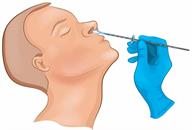ThisisPatientEngagementcontent
Viral Respiratory Infection Test
To download the Ukraine translated version, please click the link below
A respiratory panel checks if you have germs such as a virus or bacteria in your respiratory system. This system includes the nose, throat, airways, and lungs. In this test, a sample of fluid from your nose and throat is sent to a lab.
You may need this test if:It's important to know if you have a virus or bacteria, even if you don't feel sick. You can spread it to others before you feel sick. Knowing the type of germ will also help your health care provider plan your treatment.
You don't have to prepare for this test.

A fluid sample from the back of your nose and throat is collected using a swab.
The sample will be put in a tube with your name on it and sent to the lab.
Your test results will be reported as either positive or negative.
Talk with your provider about what your results mean. In some cases, more tests may be needed to confirm the results.
This information is not intended to replace advice given to you by your health care provider. Make sure you discuss any questions you have with your health care provider.
Cookies are used by this site. To decline or learn more, visit our cookie notice.
Copyright © 2025 Elsevier, its licensors, and contributors. All rights are reserved, including those for text and data mining, AI training, and similar technologies.